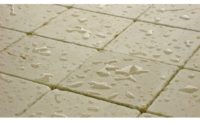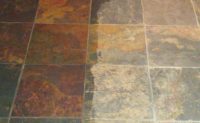
Q: What is a sealer, impregnator and penetrating sealer? How do they differ?
A: The terminology used in the stone industry can be confusing and often misused. The following are some definitions that will help clear up this confusion.
Sealer - According to Webster's Dictionary, a sealer is a coat (as of size) applied to prevent subsequent coats of paint or varnish from sinking in. In other industries, such as the cleaning and janitorial industry, a sealer is similar in that it is a coating that is placed on the surface of a substrate to seal it so something else can be applied. In the stone industry, a sealer is also defined as a coating. In the scientific community, the proper description is called a “Film Former,†since it forms a film on the surface of the stone when applied.
Impregnator - Again, according to Webster's, to impregnate means to cause to be filled, imbued, permeated or saturated. In the stone industry, the same definition applies. Impregnators penetrate below the surface of the stone and protect from within. There is no coating or film formed on the surface of the stone.
Penetrating Sealers - A penetrating sealer is really a type of oxymoron if we go by the pure definition of each term. If a sealer is a coating that sits on the surface, then how can it also penetrate into the stone? This term, however, is often used interchangeable with an impregnator. Technically you would expect that a penetrating sealer penetrates below the surface and also forms a film on the surface of the stone. While there are products that can do both, most of the products, with few exceptions in our industry do not.
Some other terms used in our industry are also worth mentioning:
Consolidants - A consolidant is a product that is used on stone to bind loose particles of the stone back together. In other words, it will glue loose stone together. These are often used on historic stone structures that become loose and brittle. This is a condition known as sugaring, since the fine stone particles are like sugar. There are numerous types of consolidants, and it is beyond the scope of this article to go into more detail. Most impregnators do not act as consolidants.
Q: How do impregnators work?
A: Impregnators work by reducing the pore size of the stone by filling these pores with a resin. The resins are small enough to prevent complete blockage of the pores, so the stone will still allow vapor to pass through while not allowing a liquid to penetrate. Some of the resins used are very hydrophobic and/or lyophobic. In other words they repel water and oil, depending on the type of resin used.
Q: Why is breatheability necessary?
A: All stone must transpire vapor. In other words, it must breathe. If a stone's pores are totally blocked, vapor will condense within the stone, and the stone will be saturated with moisture. This can lead to numerous problems such as spalling, iron oxidation, etc. The moisture can also carry soluble salts which are often deposited on the surface of the stone (efflorescence). If the salts are not allowed to escape to the surface, they will be deposited in the pores of the stone and cause deterioration.
Q: What types of impregnators are available?
A: Impregnators can be broken down into several categories. They can be water based or solvent based. Most impregnators also contain one of two main ingredients: Silicon derivatives or fluro alphatics. In general, the silicone types repel water, and the fluro types repel both water and oil. Many companies are going to strictly water-based formulas due to the fact that they are safer to use, have little odor and are better for the environment.
Q: Are sealers safe for food handling areas?
A: This will all depend on the manufacturer. Generally, once the impregnator has dried and cured, it should be safe for most food handling situations. However, to be sure, check with the products manufacturer.
Q: What problems do you see with impregnators?
A: The problems I have seen to date are few and almost always caused by misapplication of the product. If the impregnator is left on the surface of the stone and the excess is not removed, it can cause the stone to be sticky, making removal difficult.
Recently, I have seen some solvent-based impregnators reacting with resined slabs, causing clouding or discoloration.
Another problem is applying an impregnator to a wet stone. If the stone is wet, the impregnator will not penetrate and, hence, it will not perform as expected.
Overall, though, most impregnators are trouble free.
Q: How often must an impregnator be applied?
A: This will also depend on the type and use of the stone. I generally recommend that they be applied about once per year. More frequent applications may be necessary for commercial use.
Q: Does all stone need to be sealed?
A: This is an ongoing debate in the industry. There are those who say that all stone needs to be sealed and others who say that only some very porous stone types need sealing. The best test is to perform a simple absorbency trial as follows: Place about a teaspoon of water on the stone surface and allow it to sit for one to two minutes. If the stone becomes dark under the water, which indicates that it is absorbent, then the stone will need to be sealed.
Q: Are sealers UV resistant?
A: Again, this will depend on the type. In general, since they work below the surface, most will be UV resistant.
All of the above information is based on current knowledge, but one must be aware that the chemistry of impregnators and sealers can and will change. My best advice is to keep up with current trends and ask lots of questions when looking into any new product.

